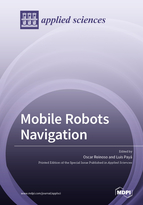Mobile Robots Navigation
A special issue of Applied Sciences (ISSN 2076-3417). This special issue belongs to the section "Mechanical Engineering".
Deadline for manuscript submissions: closed (31 May 2019) | Viewed by 65236
Special Issue Editors
Interests: computer vision; robotics; cooperative robotics
Special Issues, Collections and Topics in MDPI journals
Interests: computer vision; omnidirectional imaging; appearance descriptors; image processing; mobile robotics; environment modeling; visual localization
Special Issues, Collections and Topics in MDPI journals
Special Issue Information
Dear Colleagues,
Navigation is one of the fundamental abilities that mobile robots must be endowed with, so that they can carry out high-level tasks autonomously, in a specific environment. This problem can be addressed efficiently through the following actions. First, it is necessary to perceive the environment in which the robot has to move, and extract some relevant information from it. Second, the robot must be able to solve the localization problem within this environment. With this information, a trajectory towards the target points must be planned, and the vehicle has to be guided along this trajectory, in a reactive way, considering either possible changes or interactions with the environment or with the user.
To perceive the environment, some kinds of onboard sensors can be used, such as laser rangefinders, visual systems, or RGB-D platforms. This perception task can be carried out either beforehand or once the navigation task has started, while the robot moves through the environment, and the result is a model or map of the environment. About the localization task, it must be designed considering several issues: the available sensors, the structure of the map, and the movement constraints that the robot presents (i.e. trajectories in 3D or 6D). Furthermore, integrated exploration systems consider all these issues jointly, and they develop trajectory planning and control, while a model of the environment is obtained, and the robot estimates its position and orientation within it.
The aim of this Special Issue is to present current frameworks in these fields and, in general, approaches to any problem related to the navigation of mobile robots. In this way, this Special Issue invites contributions to the following topics (but it is not limited to them):
- Map-based navigation
- Landmark-based navigation
- Algorithms and methods for navigation
- Data fusion for mobile robot navigation
- Deep learning in mobile robot navigation
- Vision-based mobile robot navigation
- Motion control
- Localization and environment modelling
- Applications of mobile robot navigation
Prof. Dr. Oscar Reinoso
Prof. Dr. Luis Paya
Guest Editors
Manuscript Submission Information
Manuscripts should be submitted online at www.mdpi.com by registering and logging in to this website. Once you are registered, click here to go to the submission form. Manuscripts can be submitted until the deadline. All submissions that pass pre-check are peer-reviewed. Accepted papers will be published continuously in the journal (as soon as accepted) and will be listed together on the special issue website. Research articles, review articles as well as short communications are invited. For planned papers, a title and short abstract (about 100 words) can be sent to the Editorial Office for announcement on this website.
Submitted manuscripts should not have been published previously, nor be under consideration for publication elsewhere (except conference proceedings papers). All manuscripts are thoroughly refereed through a single-blind peer-review process. A guide for authors and other relevant information for submission of manuscripts is available on the Instructions for Authors page. Applied Sciences is an international peer-reviewed open access semimonthly journal published by MDPI.
Please visit the Instructions for Authors page before submitting a manuscript. The Article Processing Charge (APC) for publication in this open access journal is 2400 CHF (Swiss Francs). Submitted papers should be well formatted and use good English. Authors may use MDPI's English editing service prior to publication or during author revisions.
Keywords
- exploration
- path planning
- visual mapping
- mapping
- localization
- SLAM
- navigation







